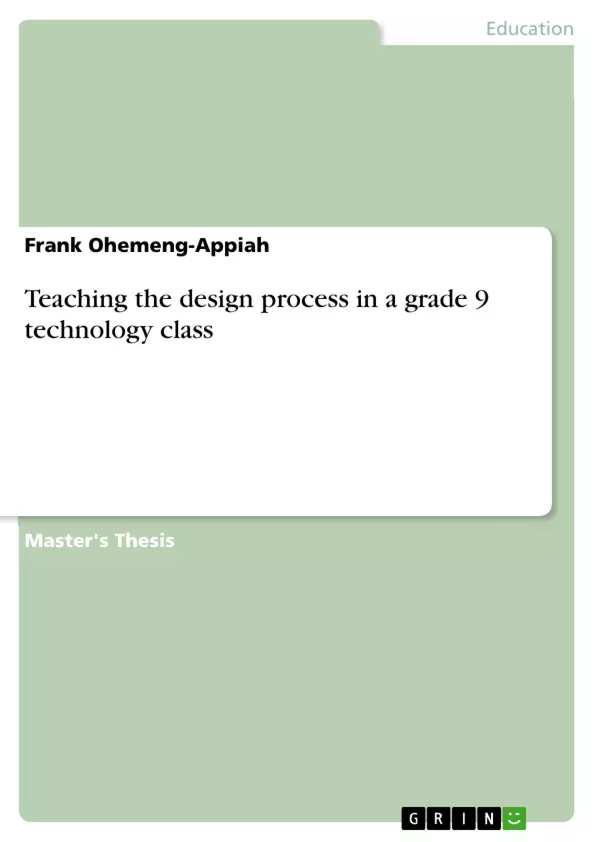This study therefore explores grade 9 technology teachers’ views of the design process and how these views influence their teaching of the design process. Shulman’s Pedagogical Content Knowledge (PCK) model (1986), the Argyris and Schön (1974) notion of “espoused theory” and “theory in use”, and Singh-Pillay’s (2010) notion of interface have been used to frame the research. A qualitative case study approach was used. Purposive and convenience sampling were used to obtain the respondents for this study. An open ended questionnaire, semi-structured interviews, observation of lessons and post-observation interviews were used to collect data.
The study occurs in the Chatsworth West ward in Durban, KwaZulu Natal. The findings indicate that grade 9 technology teachers hold two core views of the design process, namely: design process as problem-solving and design process as a step-by-step process that provides “comfort” to learners during problem-solving. The findings indicate that teachers’ views of the design process are an amalgam of their diverse qualification in technology education, their pedagogical content knowledge, their previous teaching experience, their training and (re)training and existing support in the school ecosystem. Thus, it is concluded that the PCK of the technology teacher influences how they teach the design process to their learners. It is recommended that if the non-linear approach of problem-solving in the design process is to be adhered to then there is the need for the retraining and reskilling of technology teachers and that teacher education should also focus more on the development of the PCK of future teachers.
The design process undergirds technology education and therefore it is quintessential to the teaching, learning and assessment of technology education. Since the introduction of technology education into the South African curriculum, there has been a series of changes that teachers have had to contend with: C2005, RNCS and now the NCS-CAPS. In the CAPS technology policy there has been a (re)-presentation of the design process from a linear to nonlinear. This (re)presentation of the design process has led to uncertainties amongst teachers of technology in terms of how the teaching of the design process should unfold.
Frequently asked questions
What is the purpose of this document?
This document is a comprehensive language preview including the title, table of contents, objectives and key themes, chapter summaries, and key words of an academic work. It serves to provide an overview and initial understanding of the research.
What are the key topics covered in this document?
The document primarily discusses grade 9 technology teachers' views of the design process and how these views influence their teaching. Key topics also include technology education, problem-solving, pedagogical content knowledge (PCK), curriculum development and implementation, teacher training, and reflective practice.
What does the table of contents include?
The table of contents lists the following chapters and sections: Acknowledgements, Abstract, Contents, Abbreviations, List of Tables and Graphs, Background and Educational Context, Literature Review and Theoretical Framework, Methodology, Presentation of findings and analysis, Conclusions and Recommendations, References, and various appendices detailing participants' informed consent, questionnaires, interviews, and analysis tables.
What conceptual frameworks were used in this document?
The study is framed using Shulman's Pedagogical Content Knowledge (PCK) model, Argyris and Schön's notions of "espoused theory" and "theory in use", and Singh-Pillay's concept of interface.
What data collection methods were used?
Data was collected using a combination of methods, including open-ended questionnaires, semi-structured interviews, lesson observations, and post-observation interviews.
What philosophical assumptions underpin this study?
The study is underpinned by an interpretivist paradigm and adopts a qualitative approach. This allows for an in-depth exploration of teachers' views and their influence on teaching practices.
What were the limitations of this study?
Limitations of the study include participant drop-out, time constraints that limited the number of lesson observations, and the fact that the case study findings cannot be generalized to all classrooms.
What were some core findings of this study?
The findings indicate that grade 9 technology teachers hold two core views of the design process: design process as problem-solving and design process as a step-by-step process that provides "comfort" to learners during problem-solving.
What implications does this study have?
The study's implications relate to reflective practice, professional development for teachers, resourcefulness, learner autonomy and creativity, collaborative learning, and problem-solving in technology education.
What are the recommendations of this study?
The study recommends retraining and reskilling technology teachers, focusing teacher education on the development of PCK, improving curriculum design and implementation, minimizing teacher interference during the design process, designing in collaborative groups, and promoting professional development.
- Arbeit zitieren
- Frank Ohemeng-Appiah (Autor:in), 2014, Teaching the design process in a grade 9 technology class, München, GRIN Verlag, https://www.grin.com/document/333938



